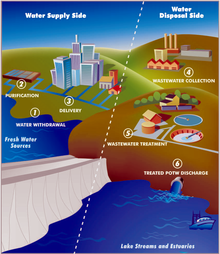Water supply network
Traditional surface water treatment plants generally consists of three steps: clarification, filtration and disinfection.Chemical addition (i.e. alum, ferric chloride) destabilizes the particle charges and prepares them for clarification either by settling or floating out of the water stream.Sand, anthracite or activated carbon filters refine the water stream, removing smaller particulate matter.These systems are usually owned and maintained by local governments such as cities or other public entities, but are occasionally operated by a commercial enterprise (see water privatization).Their planning and design requires the expertise of city planners and civil engineers, who must consider many factors, such as location, current demand, future growth, leakage, pressure, pipe size, pressure loss, fire fighting flows, etc.—using pipe network analysis and other tools.The simplest adjustment involves control of pH and alkalinity to produce a water that tends to passivate corrosion by depositing a layer of calcium carbonate.Typically, a chlorine based disinfectant, such as sodium hypochlorite or monochloramine is added to the water as it leaves the treatment plant.[1] Factors determining the extent or size of a zone can include hydraulics, telemetry systems, history, and population density.Poor people in developing countries can be close to major rivers, or be in high rainfall areas, yet not have access to potable water at all.In developing countries many governments are corrupt and poor and they respond to these problems with frequently changing policies and non clear agreements.[12] It is preferable to provide extra pipe capacity to cope with unexpected demand growth and with water outages.The multiple objective optimization problems involve computing the tradeoff between the costs and benefits resulting in a set of solutions that can be used for sensitivity analysis and tested in different scenarios.“The operational constraints include the standards of customer service, such as: the minimum delivered pressure, in addition to the physical constraints such as the maximum and the minimum water levels in storage tanks to prevent overtopping and emptying respectively.”[13] In order to optimize the operational performance of the water supply network, at the same time as minimizing the energy costs, it is necessary to predict the consequences of different pump and valve settings on the behavior of the network.These strategies must include effective management models, technical support to the householders and industries, sustainable financing mechanisms, and development of reliable supply chains.In an unsustainable system there is insufficient maintenance of the water networks, especially in the major pipe lines in urban areas.[14] The feces and graywater fraction is collected, together with organic wastes from the households, using a gravity sewer system, continuously flushed with non-potable water.[15] This project covers large spatial areas while relying on individual technological adoption decisions, offering scalable solutions that can mitigate water scarcity and enhance agricultural productivity.Grassroots movements, as observed in anti-dam protests in various countries, play a crucial role in challenging dominant development narratives and advocating for more socially and ecologically just water management practices.Developing sustainable water supply systems is a growing trend, because it serves people's long-term interests.[citation needed] Another obstacle to achieving sustainability in water supply systems is the insufficient practical experience with the technologies required, and the missing know-how about the organization and the transition process.One critical issue highlighted in recent research is the vulnerability of water networks to climate variability and extreme weather events.[19] Possible ways to improve this situation is simulating of the network, implementing pilot projects, learning from the costs involved and the benefits achieved.





Water system (disambiguation)InfrastructureGrand Coulee DamAssetsAirportsBridgesBroadbandCanalsCoastal managementCritical infrastructureElectricityEnergyHazardous wasteHospitalsIrrigation schemesLeveesLighthousesPipeline transportMass transitPublic housingState schoolsPublic spacesSewage treatmentSewerageSluicesSnow removalSolid wasteTelecommunicationTrailsUtilitiesAsset managementAppropriationLindahl taxBuild–operate–transferDesign–bid–buildDesign–buildEarmarkEuropean green infrastructureFixed costExternalityGovernment debtGreen infrastructureLife-cycle assessmentMaintenanceMonopolyProperty taxPublic–private partnershipPublic capitalPublic financePublic goodPublic sectorRenovationReplacement (upgrade)SpilloverSupply chainTaxationAir traffic controlBrownfieldCarbon footprintContainerizationCongestion pricingEcotaxEthanol fuelFuel taxGroundwaterHigh-speed railHybrid vehiclesLand-use planningMobile data terminalPork barrelRapid bus transitRecyclingRenewablesReverse osmosisSmart gridSmart growthStormwaterUrban sprawlTraffic congestionTransit-oriented developmentFuel efficiencyWaste-to-energyWeatherizationWireless technologyArchitectureChemical engineeringElectricalMechanical engineeringPublic economicsPublic policyUrban planningAkashi Kaikyō BridgeTrans-Alaska pipelineAutobahnBicycle parking stationBrazilian energy independenceBrooklyn BridgeChannel TunnelChicago wastewaterChina's high-speed railCurtiba rapid bus transitCycling infrastructurehistorysafetyDanish wind-powerBritish offshore wind-powerNuclear power in FranceSolar power in GermanyHoover DamHong Kong Int'l AirportIntercity ExpressInterstate highwaysKansai Int'l AirportOffshore wind portPanama CanalPort of ShanghaiSan Francisco Bay BridgeThree Gorges DamShinkansenSpanish high-speed railFrench TGV railSpanish autovias and autopistasTranscontinental RailroadWind farmhydrologichydraulic